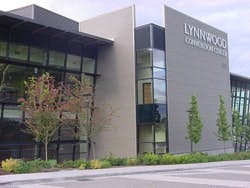The Lynwood Convention Center, located near Seattle, Wash., was the first project undertaken by the Lynnwood Public Facilities District. The district was created to spur economic growth through the development of public facilities, and to lead the planned revitalization of the city of Lynnwood.
The success of the convention center project hinged on finding a storm water management system that would meet site challenges while maximizing usable land. The existing 5.3-acre site was comprised almost entirely of existing commercial development, and the design of the convention center would result in 4.6 acres of impervious area. This left no available land for above ground detention. The district, working with Perteet Engineering, explored underground storm water storage.
However, the location available on the site was under access roads in the front of the building, and elevation constraints required shallow cover. This primarily was a concern because of the loading requirements necessary to accommodate the city's trucks, which are among the heaviest in the state. Therefore, the lids on the detention facility needed to be specially designed to handle loading requirements in excess of H-20.
"We were looking at pretty excessive costs for constructing the detention vaults," said Project Manager Erik Emerson, P.E., from Perteet. "With a fixed budget for the project, the cost was really starting to impact the ability of the architect to build the building that the client wanted."
The solution
During explorations at the site, geotechnical engineers from Zipper Zeman Associates, Inc. found a sand lens, or layer, 26 ft deep. Using this information, Perteet designed an infiltration facility that saved the District about $300,000. A 26-ft-deep, 60-ft-wide, 100-ft-long underground infiltration gallery was excavated.
"Right in the middle of the city, we dug this monstrous hole," Emerson said. "Then we backfilled it with clean drain rock to create a filled infiltration gallery."
During construction, a full scale live test was completed using a Lynnwood Fire Department truck pumping water at a flow rate of 1,500 gpm. The gallery exceeded design expectations for infiltration.
"As the gallery is very deep, there is really no way to maintain it. Our goal was to put the cleanest water as we could into it," Emerson said. He researched storm water treatment systems and found that the StormFilter can achieve levels that others cannot. The StormFilter is also the only storm water treatment BMP to earn a General Use Level Designation for Basic Treatment as a stand-alone from the Washington Department of Ecology.
The Results
In addition to garnering interest from surrounding property owners with upcoming redevelopment plans of their own, the Lynnwood Convention Center's innovative storm water system won an Engineering Excellence Silver Award in 2005 from the Washington Chapter of the American Council of Engineering Companies.
As the first step to building a downtown core, the Lynnwood Convention Center is leading the way as both the model for public facilities and for improving and protecting urban watersheds.


